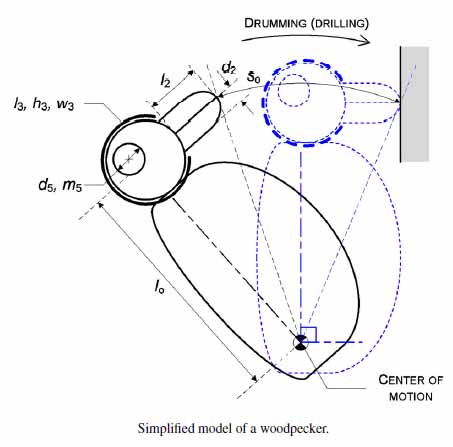“A woodpecker is known to drum the hard woody surface of a tree at a rate of 18 to 22 times per second with a deceleration of 1200 g, yet with no sign of blackout or brain damage.”
Suggesting, to some, the question : “How does the bird strike its beak against a tree repeatedly without brain damage?”
 A research team from the Molecular Cell Biomechanics Laboratory and the Department of Mechanical Engineering,
at the University of California, Berkeley, are amongst the first to
have experimentally investigated the birds’ extraordinary talents with a
view to developing novel woodpecker-inspired shock-absorbing materials.
A research team from the Molecular Cell Biomechanics Laboratory and the Department of Mechanical Engineering,
at the University of California, Berkeley, are amongst the first to
have experimentally investigated the birds’ extraordinary talents with a
view to developing novel woodpecker-inspired shock-absorbing materials.
“In this analysis, the head structures (beak, hyoid, spongy bone, and skull bone with cerebrospinal fluid) of the golden-fronted woodpecker, Melanerpes aurifrons, are explored with x-ray computed tomography images, and their shock-absorbing mechanism is analyzed with a mechanical vibration model and an empirical method.”
Based
on the analyses, the team then created a bio-inspired analogue of the
peckers’ shock-absorbing spongy bone. The new material – called BIRD II –
is in some ways similar to (though quite radically different from) bird
bone, being composed of closely-packed silicon-dioxide micro-spheres.
Its potential shock-absorption properties were tested by firing 60mm
airgun pellets at electronic chips mounted on a BIRD II sample. And the
new structure performed extremely well, reducing the failure rate of the
electronic devices to just 0.7% at exceptionally high shock levels of
60,000 g.
The paper: A mechanical analysis of woodpecker drumming and its application to shock-absorbing systems is published in Bioinspiration&Biomimetics, Volume 6, Number 1, March 2011.
(note: Here's the digital morphology used in the research [courtesy: DigiMorph at UT Austin].But what would happen to the dynamics of woodpecker drilling if, say,
they were to (try to) drill into materials other than wood? Although full a technical description of such occurrences is currently lacking in the literature, visual evidence is available – as provided in a video recently analysed in the study above.
Click here to view the video of the (confused) woodpecker (courtesy: Tom Slatin).
Yet more (possibly confused) woodpecker videos here, here, and here




Comments